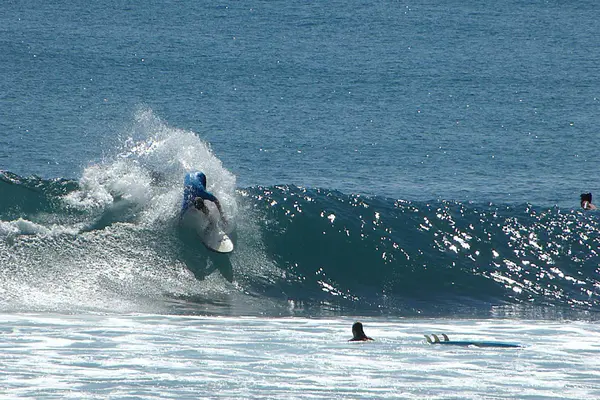Surfing is an exhilarating sport that connects you with the ocean. One important piece of equipment for surfers is the leash. The leash is the cord that attaches your ankle to your surfboard. Choosing the right length for your surf leash is crucial for both safety and performance. In this article, we will explore various aspects of surf leashes to help you decide how long your leash should be.
What Is a Surf Leash?
A surf leash is a cord that connects your ankle to your surfboard. This helps keep you connected to your board after a wipeout. The leash consists of several components:
- Cord: The main part of the leash, usually made from polyurethane.
- Cuff: Attaches to your ankle with Velcro.
- Rail saver: Protects the tail of your board from the leash.
- Swivel: Prevents the leash from tangling.
Why Use a Surf Leash?
Using a surf leash is important for several reasons:
- Safety: Prevents your board from hitting other surfers or bystanders.
- Convenience: Keeps your board within reach after a fall.
- Control: Helps you maintain control of your board in various conditions.
Standard Leash Lengths
Leashes come in various lengths. The standard lengths are:
- 6 feet: Common for shortboards.
- 7 feet: Slightly longer, often used for mid-length boards.
- 8 feet: Suitable for longboards and larger waves.
- 9 feet: Typically used for longboards in big surf.
- 10 feet or longer: Used for big wave surfing.
Factors to Consider
Board Length
One of the main factors in choosing a leash length is the length of your surfboard. A general rule is that your leash should be at least as long as your board. This ensures that the board is far enough from you during a wipeout to prevent injury.
Wave Size
The size of the waves you surf also impacts your leash choice. Bigger waves exert more force on your leash, so a longer and thicker leash is often required. For small to medium waves, a shorter leash can be sufficient.
Surfing Style
Your surfing style can influence leash length:
- Aggressive Surfers: May prefer shorter leashes for better control.
- Casual Surfers: Often opt for longer leashes for added safety.
Benefits of Different Leash Lengths
Short Leashes
Short leashes, typically 6 feet, have several benefits:
- Control: Offers more control over your board.
- Less Drag: Reduces drag in the water, making it easier to paddle and catch waves.
- Ideal for Small Waves: Best for small to medium waves where force is less intense.
Long Leashes
Long leashes, such as 8 feet or longer, offer different advantages:
- Safety: Keeps the board farther away, reducing the risk of injury.
- Big Waves: Better suited for big waves that exert more force on the leash.
- Longboards: Necessary for longboards to keep the leash from tangling.
Choosing the Right Leash for Your Board
To choose the right leash for your board, follow these steps:
- Measure Your Board: Know the exact length of your surfboard.
- Consider Wave Size: Think about the typical wave size you surf.
- Evaluate Your Style: Consider your surfing style and how it affects your leash choice.
Example Scenarios
Shortboard in Small Waves
- Board Length: 6 feet
- Wave Size: Small
- Recommended Leash: 6 feet
Longboard in Medium Waves
- Board Length: 9 feet
- Wave Size: Medium
- Recommended Leash: 9 feet
Big Wave Surfing
- Board Length: 7 feet
- Wave Size: Large
- Recommended Leash: 10 feet
See Also: Which Beach Has Water Sports in Goa?
Leash Thickness
In addition to length, the thickness of your leash is important. Thicker leashes are stronger and more durable. However, they also create more drag. Here are some guidelines:
- Comp Leashes: Thinner, for small waves and high-performance surfing.
- Regular Leashes: Standard thickness, suitable for most conditions.
- Big Wave Leashes: Thicker, designed for large waves.
Leash Maintenance
Proper maintenance of your leash is crucial for longevity and safety:
- Rinse After Use: Always rinse your leash with fresh water after surfing.
- Check for Damage: Regularly inspect your leash for nicks or frays.
- Store Properly: Avoid storing your leash in direct sunlight or extreme temperatures.
Common Leash Problems
Tangling
Tangling is a common issue with surf leashes. To prevent tangling:
- Use a Swivel: Ensure your leash has a swivel to reduce tangling.
- Untangle Regularly: Take time to untangle your leash before hitting the water.
Breaking
Leashes can break under extreme conditions. To avoid this:
- Choose the Right Thickness: Use a thicker leash for bigger waves.
- Inspect Regularly: Check for signs of wear and replace when necessary.
Environmental Impact
Leashes can have an environmental impact. To minimize this:
- Choose Eco-Friendly Brands: Some brands offer leashes made from recycled materials.
- Dispose Properly: Dispose of old leashes properly to reduce environmental harm.
Conclusion
Choosing the right length for your surf leash is essential for a safe and enjoyable surfing experience. By considering factors such as board length, wave size, and surfing style, you can select a leash that meets your needs. Remember to maintain your leash properly to ensure its longevity and reliability. With the right leash, you’ll be better prepared to tackle the waves and enjoy your time in the water.

